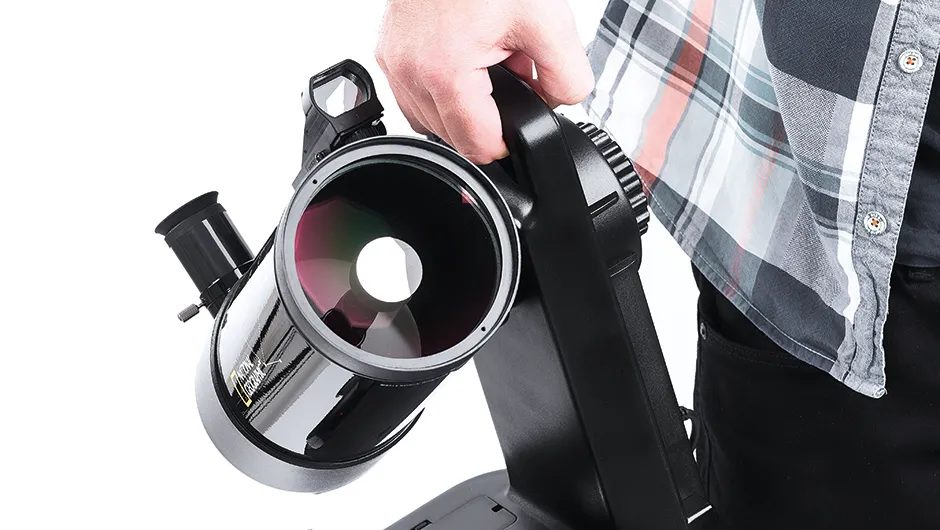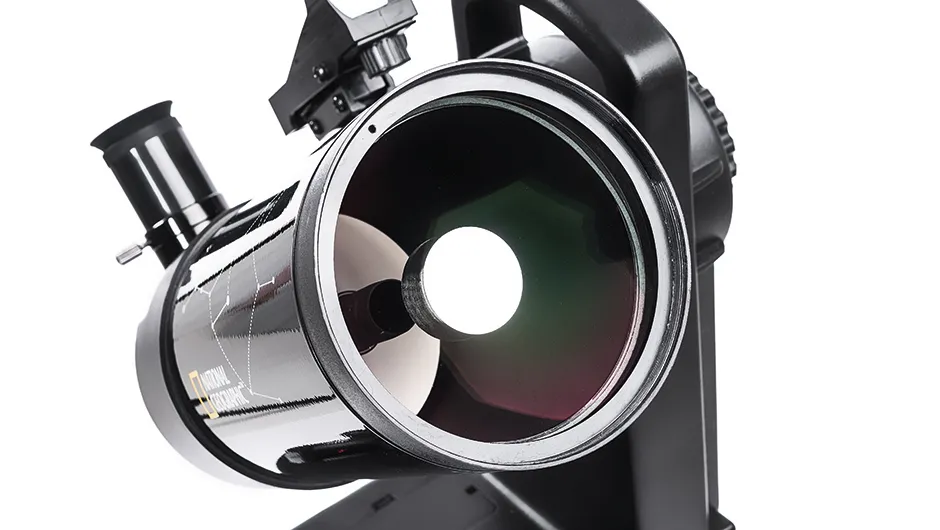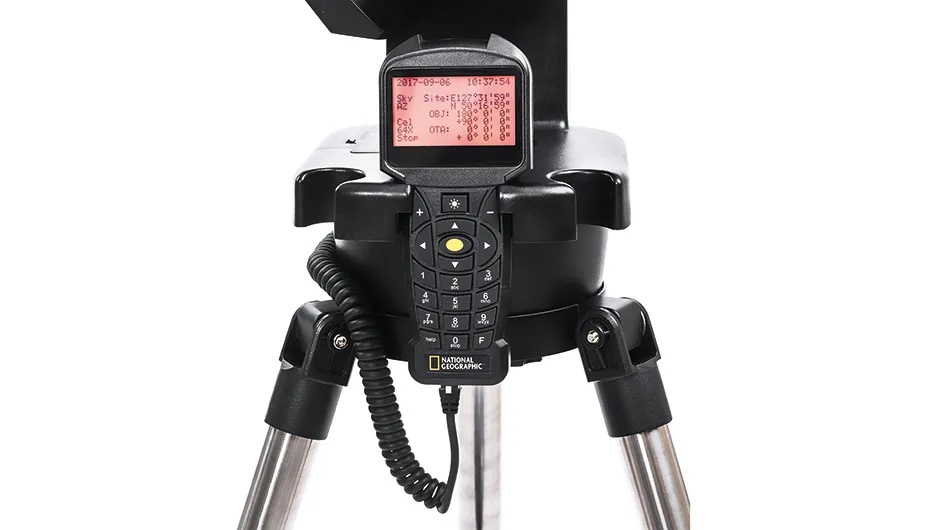This is one of a series of telescopes National Geographic has developed in conjunction with German manufacturer Bresser; a 90mm (3.5-inch) ‘automatic’ Maksutov-Cassegrain, which in this case means a computerised Go-To telescope.
This is a f/13.8 system with a focal length of 1,250mm.
The tube has the constellation of Ursa Major emblazoned on it along with the National Geographic logo.
It is attached to a single-arm mount atop a basic tripod and has a large computerised hand controller.
Also included are 25mm and 12mm eyepieces (1.25-inch fit), a red-dot finder, instruction manual, a Moon filter, a bubble level and compass, and a CD containing planetarium program Stellarium.
Power comes from by six AA batteries (not supplied); the battery compartment is set into the mount near the locking lever for azimuth motion.
For experienced users the telescope could be considered relatively basic, but to someone just starting out on the adventure of discovering the night sky then this is a good starter system that provides Go-To functionality.
By following some basic steps in the instruction manual, anyone without much prior knowledge of astronomy can soon be up and running, touring the night sky and exploring the Solar System.
The mount and telescope can be used either on a table or attached to the basic tripod, and although we did find the latter to be a little more flexible than we would have liked it does an adequate job.
Despite the flexibility, we found using the tripod to be the better option as it can be adjusted to suit your height, a critical consideration if it is going to be used by both adults and children.
Assembly was straightforward – you do not need any tools, which makes this scope ideal as a quick ‘set up and go’ system.
All you need to do is add the finder and an eyepiece, along with connecting the hand controller, and you are almost ready to start; all that’s left is the alignment routine.
This telescope features in our list of the best telescopes for kids

Finding your starter stars
When you power up the handset you have to set the time, date and your location; with the latter you can either choose the nearest city in the database or enter your own coordinates.
Level the mount, ensure the tube is horizontal and check that the setup is pointing north.
Once the handset has finished initialising you can choose an alignment routine (one, two or three stars).
The good news here is that you don’t have to know the stars: the telescope will slew itself and place the first star somewhere close in the field of view of the finder, then you can fine align to bring the star into the eyepiece.
After a successful alignment, you are ready for the sky.
We took a tour of our favourite Messier and NGC objects with the 25mm eyepiece, which gave a magnification of 50x with this scope (the 12mm eyepiece provides 100x magnification).

We felt the 12mm was close to the limit of usefulness for this type of telescope with a long focal length.
The focal ratio of f/13.8 is good for bright subjects, but faint deep-sky objects could be difficult, especially if you also have to deal with light pollution.
Bright globulars such as M13 in Hercules and M5 in Serpens were very pleasing with the 25mm eyepiece, as was the galaxy pair of M81 and M82 in Ursa Major, which just fit in the field of view.
With the 12mm eyepiece the double star Albireo in Cygnus was gorgeous, showing a great contrast between the sky blue and yellow-orange stars.
Jupiter showed its two main bands, a small but discernible Great Red spot and the four Galilean moons, whilst our own Moon sported a wealth of craters and details.
We did try some astrophotography with the system but as it has an altaz rather than equatorial mount it is not ideal for long-exposure deep-sky imaging.
However, we did find our webcam could easily record videos of the Moon and Jupiter.
This is an enjoyable beginner Go-To system, one that would have delighted us as a present if it had been around when we started out.
This scope will let you see plenty before you need to upgrade to something larger.

Epitome of convenience
Any telescope will only get used if it is convenient and easy to set up, and this instrument meets both requirements easily.
The scope, mount and tripod weigh in at a relatively lightweight 8.2kg fully assembled with accessories, and if you want to ditch the tripod and use the scope and mount on a table top the weight drops to 6kg.
The mount has several conveniences, such as the carry handle at the top of the arm allowing you to pick it up easily to transport.
There is also the slot in the mount in which to keep the hand controller, so you don’t have hold it all the time.
We also liked the two slots either side of the hand controller slot, which can take two 1.25-inch eyepieces, and indeed we found we kept the two supplied eyepieces in those slots during the review with dust caps on them for protection.
Simple yet effective design choices such as these add to the value and usefulness of any telescope.
Hand controller
The hand controller has a database of 272,000 objects, including those in Messier, NGC and Caldwell catalogues, planets, named stars, double stars, variable stars and more. It has an eight-line red light LCD display with a multitude of options, along with an integrated red light torch at the top.
Tripod
The tripod is a little flexible – on touching the system, it takes a few moments for any vibrations to die down but otherwise it does its job. It can be adjusted for height and features a useful spreader tray for eyepieces and other accessories.
Single-arm altaz mount
The mount is sturdy and easily attaches to the tripod via two bolts. There are ports for the hand controller, power from an external tank and an aux port. The mount can also be powered by six AA batteries and there is a useful carry handle.
Accessories
A good selection of accessories helps to make this a complete system. They include 25mm and 12mm eyepieces, a Moon filter, a Bresser planisphere, a bubble level and compass for levelling and lining up the system, a CD with the Stellarium planetarium software and a multi-language instruction manual.
Optics
The 90mm (3.5-inch) Maksutov-Cassegrain optics have a focal length of 1,250mm, giving a focal ratio of f/13.8. It gave good views of the stars out to 85-90 per cent of the field of view with the supplied 25mm eyepiece, with only minor distortion towards the edge.
Vital stats
- Price £357.00
- Aperture 90mm (3.5 inches)
- Focal Length 1,250mm (f/13.8)
- Mount Computerised single fork arm altaz
- Weight 8.2kg
- Supplier Telescope House
- Tel01342 837098
- www.telescopehouse.com
This review originally appeared in the August 2017 issue of BBC Sky at Night Magazine.

